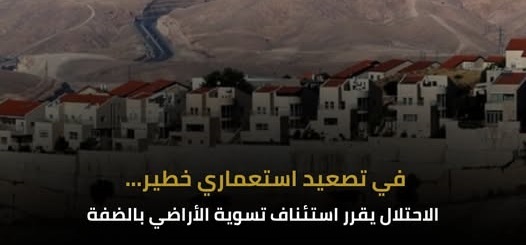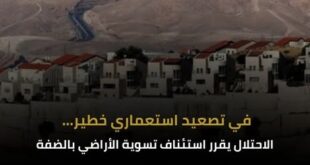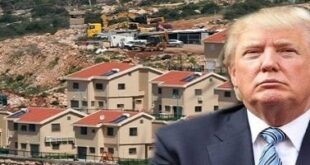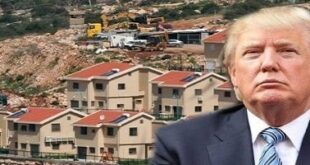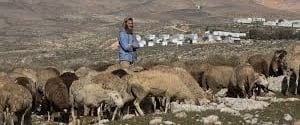By: Madeeha Al-A’raj
The National Bureau for Defending Land and Resisting Settlements stated in its latest weekly report , thatlast Sunday, the Israeli Occupation Authorities have reopened files that were suspended over years, where the Israeli Political-Security Council ‘the Cabinet’ approved a joint proposal submitted by Ministers, Katz, and Smotrich, to resume land registration plan in the West Bank, and halt what they described as the Palestinian Authority’s illegal attempts to seize land in Area C. According to the text of the decision, the occupation government will resume official procedures for land settlement and registration in the West Bank, while all steps taken by the Palestinian Authority in these areas, including maps, documents, and approvals, will be considered illegal. The Israeli security establishment will also work to prevent the continuation of the Palestinian settlement activities, prevent the entry of any professionals into these areas, and obstruct any foreign support allocated for these efforts, directly demand the Palestinian Authority to halt such measures.
Katz announced to issue instructions to renew the land settlement process through local Israeli authorities. Military legislation would be updated to suit the move, and a joint ministerial team would be formed to complete professional, legal, and financial preparations within 60 days, added that the decision ‘will restore prestige to Jewish settlement in Judea and Samaria i.e. the (West Bank), thwart the Palestinian Authority’s attempts to control Area C, and establish a comprehensive settlement in land registration led by the Army Ministry.’
Smotrich explained that the land settlement would provide a stable legal basis, allow for the allocation of land reserves for settlement expansion, and thwart the Palestinian Authority’s efforts to control open land, added this step is part of a larger plan that includes regulating emerging settlements, developing roads and infrastructure, and accommodating a million new settlers, strengthening the security belt and preventing the establishment of a Palestinian State. He emphasized that the decision falls within the ‘revolution of imposing actual sovereignty’ over the West Bank, indicating assume direct responsibility on Area C as part of its permanent sovereignty, and will begin practical steps to settle the lands there.
Accordingly, the occupation authorities ignore the International Road Map of 2003, which called for a halt to construction in settlements, even for the purposes of natural growth, and for the dismantling of all settlement outposts established in the West Bank. They also ignore UN Security Council Resolution No. 2334 of 2016, which confirms the illegality of settlements and calls for their dismantling, the advisory opinion of the International Court of Justice of 2024 on the necessity of halting settlements and ending the illegal occupation of Palestinian territories, and many other international resolutions.
They also ignore legislation that President Mah’d Abbas has issued in his capacity as President of the State of Palestine, Chairman of the Executive Committee of the PLO, on March 3, 2016, based on the recommendation of the Council of Ministers on Feb. 16, 2016, and by virtue of which he established a public institution called the ‘Land and Water Settlement Authority,’ which is entrusted with exercising the tasks and powers stipulated in Land and Water Settlement Law No. 40 of 1952 and its amendments, and all legislation related to land settlement, in addition to carrying out land and water settlement work between all those who have the right to dispose of, own, or benefit in the areas of the State of Palestine, whether this right is recognized or disputed.
The discussions taking place within the corridors of power in the occupying state, whether in settlement councils, Knesset committees, or the government, indicate that Israel will proceed with its settlement offensive on Area C lands by accelerating the legalization of their confiscations. The Civil Administration’s West Bank land settlement project is considered the most dangerous project since the occupation, as it prepares the legal groundwork for actual annexation. Through this illegal behavior, it disputes the Palestinian side, represented by the State of Palestine under occupation, its right to land ownership, especially in Area C and perhaps even wider than that.
It is known that the Palestinian Authority has begun land settlement work early on in 2006 through a pilot project funded by the Finnish Government. This is considered the first settlement in Palestinian history with Palestinian crews. It began in the northern governorates, in the towns of Qarawat Bani Zeid, Bitunia, and Bir Nabala, and then the Bethlehem and Hebron Governorates.
By returning to the early years of the occupation, after Israel occupied the West Bank in 1967, the military governor at the time issued a decision to freeze land settlement and registration projects, which began during the British Mandate period, and were resumed by the Jordanian Authorities after 1948. This military decision no. 291 of 1968 didn’t cancel the settlements that took place up to that time, which covered 33% of the West Bank, but rather froze them and according to Israeli calculations allowed for disputes over the remaining 66% of the West Bank, in the absence of official land settlement, judicial disputes theoretically allow for the recognition of a party’s ownership of any plot of land ‘even in the absence of a title deed’ if this is proven through judicial means.
Following Israeli government Resolution no. 145 of 1979, which specified the locations for settlement construction, the Israeli Civil Administration established the ‘Central Inspection Unit’ in 1983. The unit’s purpose is to inspect land, monitor illegal construction, and examine the status of the land. The “Inspection Unit” is also tasked with identifying loopholes and legal justifications that would allow for the confiscation of other lands for the benefit of the state, or to create justifications for preserving previously confiscated lands in the face of any future legal dispute. Accordingly, the Civil Administration has adopted a policy of announcing its land confiscations in newspapers to open the door to legal disputes.
Even though the outcomes of legal disputes or protests were known in advance, this allowed the Israeli government, according to its claims, to give the confiscation process a quasi-legal character. The work of this unit was limited to Area C after the signing of the Oslo Accords, but it still lacked a systematic plan for final land settlement. During the first years of Oslo, the Civil Administration’s human resources shrank, its budget fell by about a quarter, and the process was frozen without being removed from the agenda of the occupation authorities and the Israeli government.
Noting that, the Israeli Knesset approved the ‘Regulation Law’ in Dec. 2016, by a majority of 60 votes to 52. This law allows for the confiscation of large areas of private Palestinian land, giving absolute priority to the political interests of Israel as an occupying power and of Israeli settlers residing in the occupied Palestinian territories, thus, violating the property rights of Palestinian citizens. The primary purpose of the law was to legitimize further illegal settlements in the West Bank for political reasons, directly contradicting Security Council Resolution 2334 of 2016, which reaffirmed the illegality of Israeli settlements.
This legislation passed by the Knesset, clashed with petitions submitted by human rights organizations, such as, Adalah, the Jerusalem Legal Aid and Human Rights Center, and the Al-Mezan Center for Human Rights in Gaza, on behalf of 17 Palestinian local and regional councils. The petitions sought to repeal the Regularization Law, which allows Israel to legalize settlements built on privately owned Palestinian land in the West Bank through the actual confiscation of the land, its planning, and the licensing of construction. The law was intended to legalize settlement outposts and neighborhoods built on private Palestinian property, numbering more than 2,000 units spread throughout the occupied West Bank.
The petitions were submitted to the Israeli Supreme Court, which halted the legislation, which allows the occupying state to confiscate private Palestinian land in the West Bank to retroactively legalize settlement outposts built there. The court deemed it ‘illegal,’ allowing, under pressure from settlers, the legalization of settlement outposts established illegally under Israeli law itself, some of which were built on private land belonging to Palestinian residents of the West Bank.
At the time, Supreme Court President Esther Hayut asserted that this ‘strangely violates the property rights of Palestinian residents and creates discrimination between Israelis and Palestinians in the area.’ The petitioners considered the ruling ‘a significant achievement, especially against Israel’s intended annexation plans. The Supreme Court’s ruling emphasizes that the Knesset cannot enact laws that contravene international law, and no circumstances can justify the commission of serious criminal offenses, most notably the displacement of Palestinians and the confiscation of their land for Jewish settlement.’
Despite the suspension of this racist legislation, the petitioners and targeted citizens continued to view with concern the possibility of circumventing the decision and using other means to confiscate Palestinian lands, or inventing new means, especially with the Israeli government’s statements about annexing large areas of the West Bank to its sovereignty under appropriate circumstances, including the statements of the FM and the Minister of Settlement in the Ministry of Army regarding considering the year 2025 as the year of choice.
By resuming land registration, as approved by the Israeli Security Cabinet, the occupying state is turning its back not only to the International Law but also on the aforementioned decision of the Israeli Court of Justice. The occupying state is moving forward with its most dangerous project to entrench annexation as a de facto reality on the ground. The Land Registration Unit affiliated to the Coordinator of Government Activities in the Territories will be responsible for regulating and registering land ownership in Area C, including issuing sales permits, collecting fees, and supervising registration procedures.
At the same time, it will prevent the Palestinian Authority from performing its duties in these areas. The International Court of Justice, in a public session in the Hague on July 19, 2024 affirmed that ‘the continued presence of the State of Israel in the occupied Palestinian territory is illegal,’ emphasizing that the Palestinians have ‘the right to self-determination’ and that ‘the Israeli settlements in the occupied territories must be evacuated.’
Within the context, the PM Netanyahu said, ‘Tel Aviv will be able to annex 30%’ of the occupied West Bank, stressing that there is no disagreement with US President Trump, and that what is being promoted in the media about this is politically motivated. Netanyahu added, during a meeting of the Foreign Affairs and Security Committee last week that there has been no change in his position since the ‘Deal of the Century’ announced by Trump regarding annexation, and that the Palestinians will be able to manage their lives, and we will be able to annex 30% of the lands in the occupied West Bank.
On another level, the Israeli Ministry of Heritage, Amhai Eliyahu recently began excavations to establish the ‘Samaria National Park’ at the archaeological site of Sebastia, following the Israeli government’s decision on that. In this regard, Israel’s Channel 7 reported that Sebastia, located north of Nablus, was the capital of the Kingdom of Israel during the First Temple period and was known as ‘Samaria.’
The archaeological site contains important archaeological remains that bear witness to different historical periods. Eliyahu claimed that ‘Sebastia is one of the most important historical sites in our national and historical heritage, and that establishing the Samaria National Park at the site is an important step towards preserving the Jewish and cultural heritage of Israel’, adding that work has begun with a budget of NIS 32,000,000, and that his ministry will invest NIS 4,000,000 to rehabilitate the old train station near Sebastia as part of encouraging heritage tourism in there.
List of Israeli Assaults over the Last Week Documented by the National Bureau:
Jerusalem:
- Handing over a demolition order to the residents of the “Al-Wa’d Building” in Wadi Qaddum within two weeks. The building includes 12 apartments, and accommodates about 85 Jerusalemites.
- Demolishing a house in the Wadi Yasul Neighborhood in the Silwan town, belonging to Hani Al-Ja’bari, under the pretext of building without a permit. They also forced Jerusalemite Muhammad Odeh to forcibly demolish a room in a brick factory in the Al-Bustan Neighborhood in the town under the same pretext.
- Bulldozing rooms, walls, electricity lines and trees in the Anata town, north of Jerusalem, in the Al-Buhaira Neighborhood.
- Forcing Adam Moh’d Shaqirat to demolish his 100-square-meter house that housed 8 people, it was built in 2016 in the Jabal al-Mukaber.
- Demolishing a house in the Um Tuba village, belonging to the Abu Teir family, and fences belonging to the Bashir family in the al-Bustan Neighborhood of Silwan for the second time in a row.
Hebron:
- Storming the lands of citizens in the Beit al-Rush village, southwest of Hebron.
- Attacking the villagers, threw stones at them, prevented them from leaving their homes, and threatened to kill them in the Susiya village.
- Demolishing the house of Ala’ al-Batran, which was inhabited for ten years in the Suba area, east of the town of Idhna.
- Attacking the Khallet al-Daba’ village and assaulted the residents with clubs and sharp tools, resulting in a deep wound to the head for Suleiman Ali Dababseh, who was subsequently transferred to Yatta Governmental Hospital. The occupation forces, who were present to protect the settlers, detained the ambulance and tried to prevent it from transporting Dababseh with the aim of arresting him. Other settlers vandalized barbed wire and crops and cut down trees on citizens’ lands in the same area.
- Gathering inside the ‘Havat Ma’on’ settlement and attempted to attack citizens near the At-Tuwani villages, while a number of them chased shepherds near the settlement.
Bethlehem:
- Demolishing an agricultural facility, a livestock barn, and destroyed stone fences, belonging to Khader Issa Abu Ahour, under the pretext of lacking a license, in the ‘Khallet al-Nahla’ area near the Wadi Rahhal village, south of Bethlehem.
- Seizing a drinking water well in the ‘Wadi al-Abyad’ area in the Al-Minya desert, belonging to the Abu al-Nour family, and built a pool next to it, and pumped water into it.
- Bulldozing citizens’ lands and installed mobile homes in the area in the Beit Ta’mar area.
- Demolishing a house and a sheep barn in the village of Kisan, belonging to Hussein Yousef Obeyat. The house consists of one floor, with a total area of 200m2, under the pretext of lacking a permit. Meanwhile, the occupation forces began surveying lands in the Al-Minya desert, east of Bethlehem, in the areas of ‘Fateh Sadra and Nasb Abu Za’rour’, estimated at about 300 dunams.
Ramallah:
- Setting fire to large areas of agricultural land in the Al-Mughayir village in the Marj Al-Dhahab area, destroying large areas of agricultural land belonging to citizens in the area. Attacked the Al-Khalayel area in the village and assaulted members of the Abu Hammam family residing in the area.
- Invading the Beit-Elo village from the eastern side and assaulted citizens who tried to confront them. After the citizens confronted the groups of settlers and forced them to retreat, the settlers set fire to lands in the eastern area of the village.
- Bulldozing several dunams of the Um Safa village’s land in the Jabal Al-Ras area. In the village of Shuqba, the occupation forces demolished an inhabited house in the village, belonging to Yaqoub Hamida Qadah, which consists of two floors, with an area of 250 square meters.
Nablus:
- Demolishing a two-story house south of Nablus, in the upper Ta’wun area south of the city. One of the houses was inhabited and the other was under construction, belonging to Majed Al-Adham, under the pretext of building in Area C without a permit.
- Uprooting scores of olive trees and razed agricultural lands without prior warning in the Duma village. They also demolished a house in the village of Majdal Bani Fadel under the same pretext.
Jordan Valley:
- Attacking citizens’ properties near Al-Auja Spring, obstructed citizens and their vehicles from entering the spring, and attacked other vehicles, causing damage to them, in an attempt to prevent them from coming to the area. Storming the tents of a Palestinian family east of Tubas, and arrested a number of its members, including Jihad Saleh Masaeed, Faisal, Muhammad, and Kamal Daraghmeh. Others destroyed surveillance cameras and internet equipment in the ‘Naba Ghazal Al-Farisiya Ccommunity’, which citizens use to document and monitor the daily attacks they are exposed to in the area.
- Stealing a water tank belonging to Mah’d Faris Fuqaha, who uses it to water his livestock in the Al-Sakut area in the northern Jordan Valley.
 المكتب الوطني للدفاع عن الارض ومقاومة الاستيطان منظمة التحرير الفلسطينية
المكتب الوطني للدفاع عن الارض ومقاومة الاستيطان منظمة التحرير الفلسطينية
